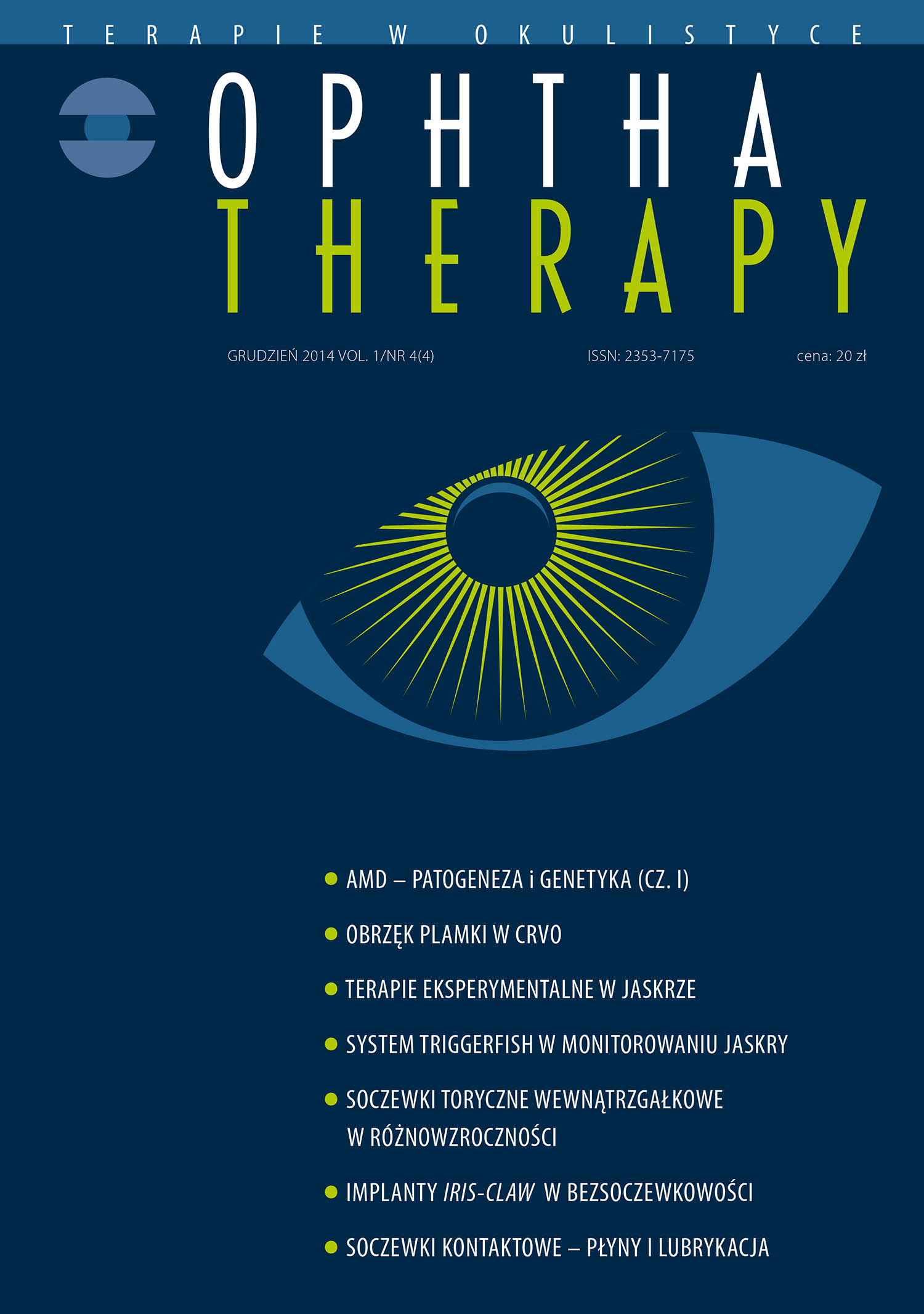The use of iris-claw intraocular lens in patients with aphakia
Main Article Content
Abstract
Iris-claw iris fixated IOLs are one of the options of optical correction of aphakia in cases without capsular support for conventional posterior chamber lens. They provide an alternative to scleral fixated or iris sutured implants. Implantation procedure is relatively simple and short. Recovery period after surgery is shorter, there is low rate of postoperative complications and the final visual acuity stabilizes faster than after scleral fixation. Retropupillary implantation of iris-claw IOLs seems to be a better choice to their fixation in the anterior chamber in regard to corneal endothelial cell loss. Contraindication for their use is uveitis, uncontrollable glaucoma and proliferative diabetic retinopathy. Retropupillary iris-claw lens implantation seems to be safe, effective, in many cases the best method for the correction of aphakia in lack of zonular support
Downloads
Article Details

This work is licensed under a Creative Commons Attribution-NonCommercial-NoDerivatives 4.0 International License.
Copyright: © Medical Education sp. z o.o. License allowing third parties to copy and redistribute the material in any medium or format and to remix, transform, and build upon the material, provided the original work is properly cited and states its license.
Address reprint requests to: Medical Education, Marcin Kuźma (marcin.kuzma@mededu.pl)
References
2. Farrahi F, Feghhi M, Haghi F et al. Iris-claw versus scleral fixation intraocular lens Implantation during pars plana vitrectomy. J Ophthalmic Vis Res. 2012; 7(2): 118-24.
3. Gonnermann J, Amiri S, Klamann M et al. Endothelial cell loss after retropupillary iris-claw intraocular lens implantation. Klin Monbl Augenheilkd. 2014; 231(8): 784-7.
4. Gonnermann J, Klamann MK, Maier AK et al. Visual outcome and complications after posterior iris-claw aphakic intraocular lens implantation. J Cataract Refract Surg. 2012; 38(12): 2139-43.
5. Güell JL, Verdaguer P, Elies D et al. Secondary iris-claw anterior chamber lens implantation in patients with aphakia without capsular support. Br J Ophthalmol. 2014; 98(5): 658-63.
6. Hara S, Borkenstein AF, Ehmer A et al. Retropupillary fixation of iris-claw intraocular lens versus transscleral suturing fixation for aphakic eyes without capsular support. J Refract Surg. 2011; 27(10): 729-35.
7. Häberle H, Schiedel S, Pham DT. Retroiridal iris-claw lens as routine procedure. Klin Monbl Augenheilkd. 2014; 231(10): 995-8.
8. Kanigowska K, Grałek M, Czarnowska E et al. Przemieszczenie soczewki z fiksacją śródtwardówkową w wyniku degradacji szwu polipropylenowego ? opis przypadku. Klin Oczna. 2009; 111(4-6): 138-41.
9. Lett KS, Chaudhuri PR. Visual outcomes following Artisan aphakia iris claw lens implantation. Eye (Lond). 2011; 25(1): 73-6.
10. Schallenberg M, Dekowski D, Hahn A et al. Aphakia correction with retropupillary fixated iris-claw lens (Artisan) ? long-term results. Clin Ophthalmol. 2014(8): 137-41.
11. Sedaghat M, Zarei-Ghanavati M, Ansari-Astaneh MR et al. Evaluation of sterile uveitis after iris-fixated phakic intraocular lens implantation. Middle East Afr J Ophthalmol. 2012; 19(2): 199-203.
12. Sminia ML, Odenthal MT, Prick LJ et al. Long-term follow-up of the corneal endothelium after aphakic iris fixated IOL implantation for bilateral cataract in children. J Cataract Refract Surg. 2011; 37(5): 866-72.
13. Sminia ML, Odenthal MT, Wenniger-Prick LJ et al. Traumatic pediatric cataract: a decade of follow-up after Artisan aphakia intraocular lens implantation. J AAPOS. 2007; 11(6): 555-8.
14. Teng H, Zhang H. Comparison of Artisan iris-claw intraocular lens implantation and posterior chamber intraocular lens sulcus fixation for aphakic eyes. Int J Ophthalmol. 2014; 7(2): 283-7.
15. Teng H, Zhang H, Tian F et al. Artisan iris-claw intraocular lens implantation for the correction of aphakia after pars plana vitrectomy. Zhonghua Yan Ke Za Zhi. 2014; 50(2): 89-94.

